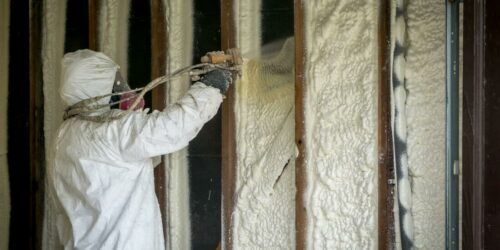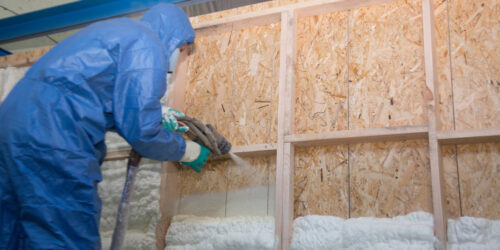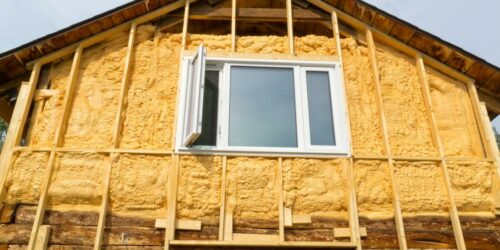How Thick Should Loft Insulation Be?
- Minimum loft insulation thicknesses
- How spray foam insulation compares
- How to decide on the best loft insulation for you
In order to achieve the optimal level of energy efficiency in a home, insulation should be installed at a minimum recommended thickness. According to Building Regulations, loft insulation should be 270mm. If you live in a home that was built before 2003, your home is likely to have much less than the updated level.
This article will explain why such a high thickness level is necessary for insulating a loft and how much it can potentially cost for you to get there. It will also discuss the best loft insulation for you, which could be different from the traditional materials used, such as the more modern spray foam insulation.
Looking for insulation? Use our quote comparison tool to find out how much you'd pay. It only takes a minute.

What's On This Page?
Click the links below and head straight to a specific section of the article.
Loft Insulation U-Values
When it comes to insulating a home, the minimum thickness all comes down to U-values. These are simply a measure of heat loss, or thermal transmittance, measured in watts per metre squared Kelvin (W/m²K). The lower the U-value, the better the insulation. Different parts of a building will require greater or lower U-values. According to Building Regulations, refurbishments to an existing building have the following minimum requirements:
Walls: 0.3
Floors: 0.25
All roofs: 0.16
In other words, loft insulation needs to be the most efficient in any home, with the lowest U-value.
How Does Spray Foam Insulation Differ?
One of the reasons why spray foam insulation is so popular is because much less needs to be applied to achieve lower U-values. Closed cell spray foam has better insulating properties and can achieve in 150mm what traditional materials can in 270mm. Some spray foams have a U-value as low as 0.039 because it is so airtight.
What Do Building Regulations Say About Loft Insulation?
Historically, the minimum thickness for insulation has been relatively low. As our understanding of thermal conductivity has increased over the decades, this has steadily improved. You can see how minimum loft insulation thickness levels have changed over the years in the interactive graph below.

The recommended thickness hasn’t gone above 270mm because extra padding can cause more problems. Including poor ventilation and an increase in the chances of condensation, damp and mould, additional insulation on top of the recommended thickness will not serve you much use.
Also, the law of diminishing returns applies to insulation. While the first 75mm of insulation will prevent most of the heat loss, continually adding more insulation will only decrease heat loss by a smaller amount each time. For example, if you already have 250mm of loft insulation installed, adding 20mm to get to the minimum level will save you money on your heating bills, but only by a miniscule amount.
Benefits of Installing Extra Loft Insulation
As around a quarter of a home’s heat can be lost through an uninsulated roof, anyone without any loft insulation will benefit the most from installing 270mm of it. Energy Saving Trust reports that a detached house can save £590 a year on energy bills if installing 270mm of insulation in the loft where none existed before. If upgrading the thickness from 120mm, this yearly saving drops to £55.
How Much Will Loft Insulation Cost and What’s the Payback?
In terms of loft insulation cost, a detached home will typically spend around £1,200 to get 270mm fitted. To top up 120mm to 270mm, a detached home will spend about £930. The payback period for a home with no previous insulation will be much shorter than a home topping up their existing stock. The first example will take just over 2 1⁄2 years to pay it back through energy bill savings, while the second example will take just over 20 years.
You can see different payback periods in the interactive graph below, depending on house type and insulation thickness.
You will see a benefit from upgrading your loft insulation, no matter how much you currently have installed, but it will be less of a benefit the more you already have.
What’s the Best Loft Insulation for Me?
Types of Insulation
Of course, there are many different kinds of insulation for your loft, and they all have distinct properties. Of the most common, the following minimum thickness is recommended:

Glass wool: 270mm
Mineral wool: 250mm
Cellulose: 220mm
Spray foam: 150mm
Costs
The costs and savings spoken about so far have all been to do with traditional glass wool insulation. In terms of cost, glass and mineral wool insulation are some of the cheapest options, as they are categorised as blanket insulation. It is around £5 per m².
Cellulose can come as blankets, but is normally used as loose-fill insulation. This can cost between £4.80-£6.40 per m². Spray foam, on the other hand, is pricier at £44-£52 per m². This is simply because of the specialist equipment that is needed to install it and the technical nature of spray foam as a material.
Which to Choose?

To decide which loft insulation is best for you depends on your budget, what you’re hoping to achieve and whether you already have any insulation in your loft. If you’re looking to top up existing insulation to the recommended 270mm amount, it’s worth doing unless you already have 250mm applied. The difference of 20mm will have a much longer payback period and it won’t have too much of an impact on your property.
If, however, you currently have no loft insulation, or less than 200mm, it is definitely worth your time to get it installed. While spray foam is more costly, it can insulate more effectively if space is an issue for you. If cost is a factor, blanket insulation, such as glass or mineral wool, will be a good option to choose.
Installation costs can drive up the price, but blanket insulation can be fitted yourself without professional help. If you are thinking of saving on the price of labour, you need to make sure you’re wearing protective clothing applicable to your chosen material. Irritation can occur with some types, so gloves and goggles are a must. Spray foam cannot be installed yourself, at least for the sake of having it done properly without any issues occurring, either to the property of your health.
Related articles
View all Insulation articles
How Long Does Spray Foam Insulation Last?

Can I Install DIY Spray Foam Insulation Myself?

Six Benefits of Spray Foam Insulation

Is My Property Suitable for Spray-On Insulation Foam?

Why Consider Spray Foam Insulation in Roofs?

Icynene Spray Foam Insulation: A Complete Guide

Spray Foam Insulation Installers: What to Expect







